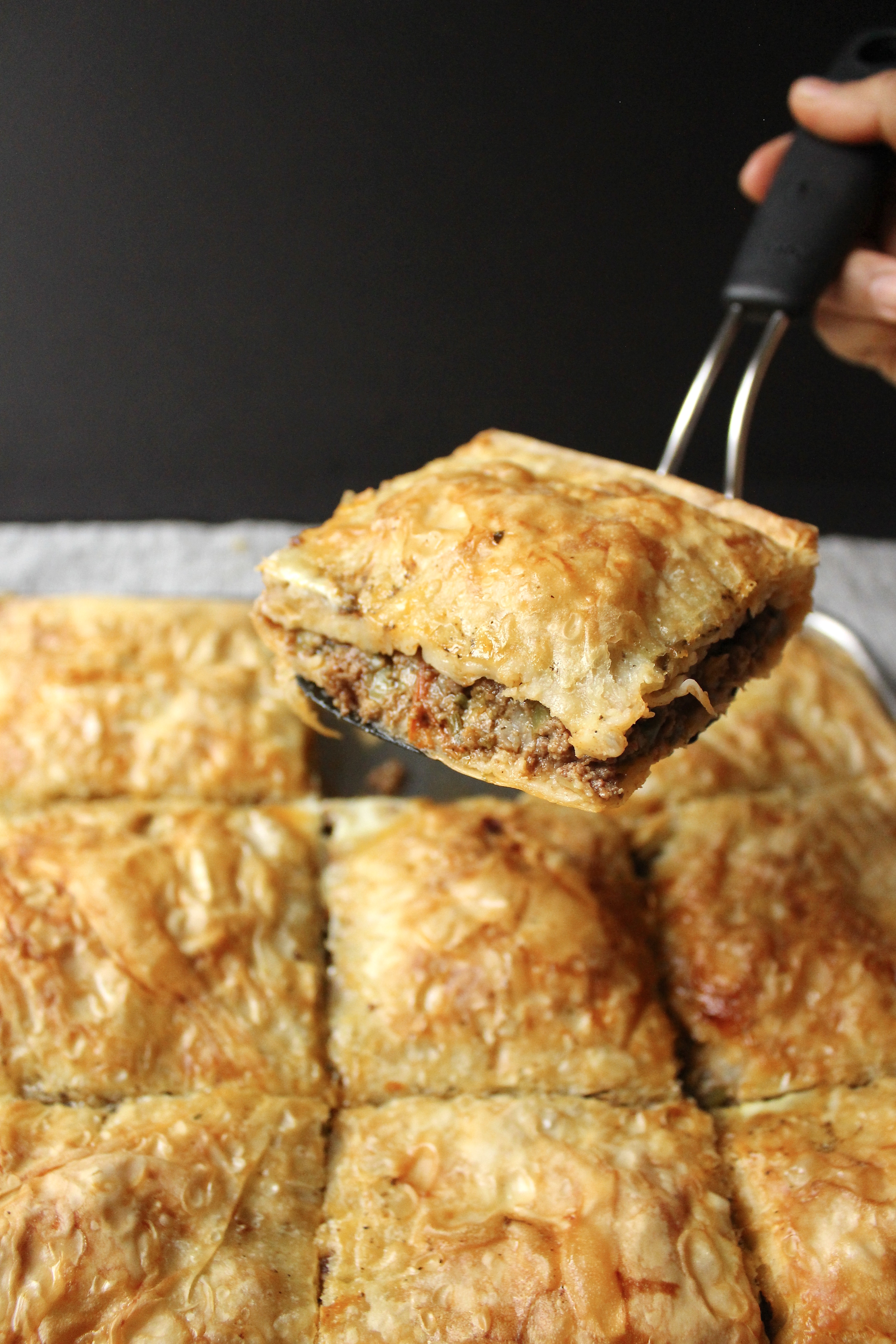
This is the story of how a typo turned into an entree. In Whatsapp group of fellow moms, coordinating the dishes of a potluck, someone offered up a Samoa cake. Misreading that for “Samosa Cake” many of the moms jumped at the prospect: “Samosa cake?! What’s a Samosa Cake?! I want to try it!!”. After clarifying the mix up, some ideas were thrown around as to what a samosa cake would look like. I immediately thought of layers of phyllo dough stacked with a samosa meat mixture, baked and cut in slices. When I looked up for recipes that would meet these requirements, I pulled together elements from a Borek recipe (Turkish layered meat pastry), an Egyptian meat pie, and the filling from a Yemeni Samboosa. There are cubanelle or italian frying peppers here for flavor, often seen in Turkish recipes. There’s tomato paste from the samboosa recipe, an ingredient that is necessary for any red meat dish, in my humble opinion. And the whole layering and baking technique pulls from Egyptian meat pie recipe.
Turkey Korma

I woke up the morning after Thanksgiving like I imagine a runner feels the morning after a race: like I got hit by a truck.
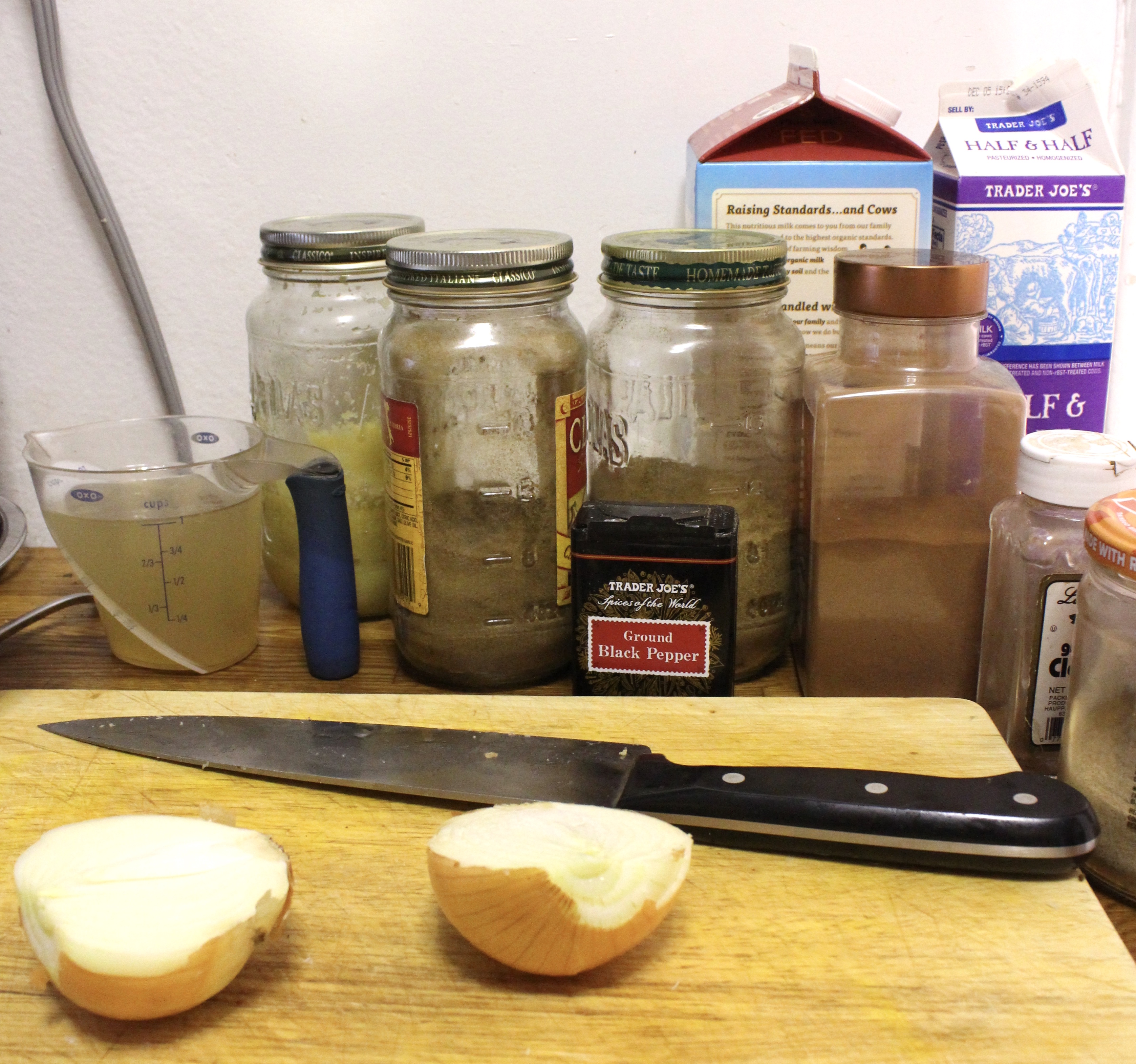
A whole week of groceries, prep, planning culminating in an evening with loved ones and good food. It was EXHAUSTING and I was happy to do it.

But even after the last doggy bag was packed, we had quite a bit of turkey left over. It’s been our breakfast, lunch and dinner. Then last night, I recalled my friend Biny of #binyskitchen saying how she’d use her leftovers for turkey pot pies. Now, pot pies don’t fly here, but South Asian flavors do. I thought I’d cook some of the leftover turkey in a cream sauce with spices and frozen peas (to make it the slightest bit healthy) and the gang inhaled it!
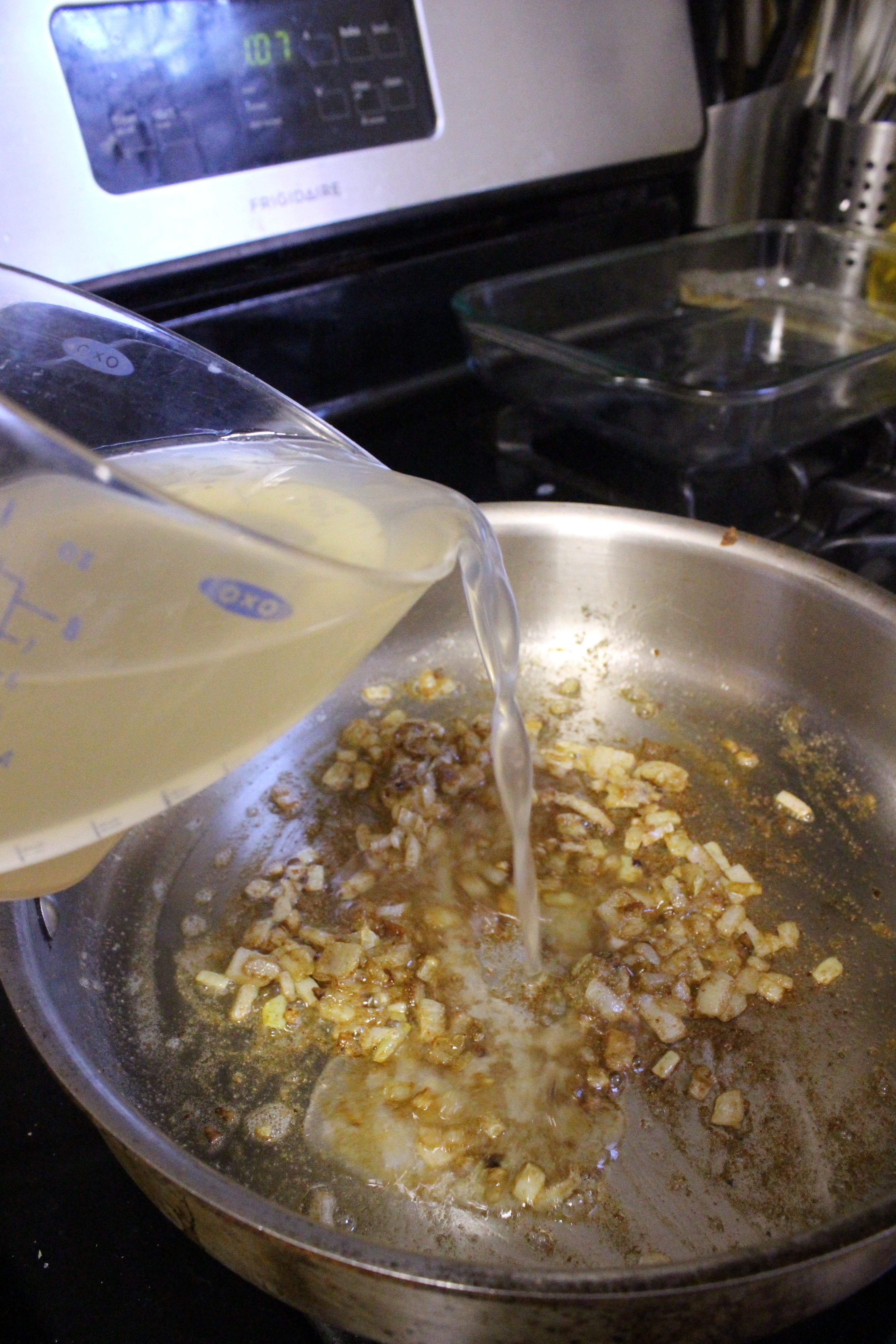
So here’s how I created it. Don’t be intimidated by the long list of ingredients. If you ever want to make South Asian food at home, you need these in stock. Fine to use a “garam masala” mix if you don’t have the last 5 spices. I wouldn’t use a curry powder to sub the first few spices, as that has turmeric and chili powder and would change the flavor of the korma.
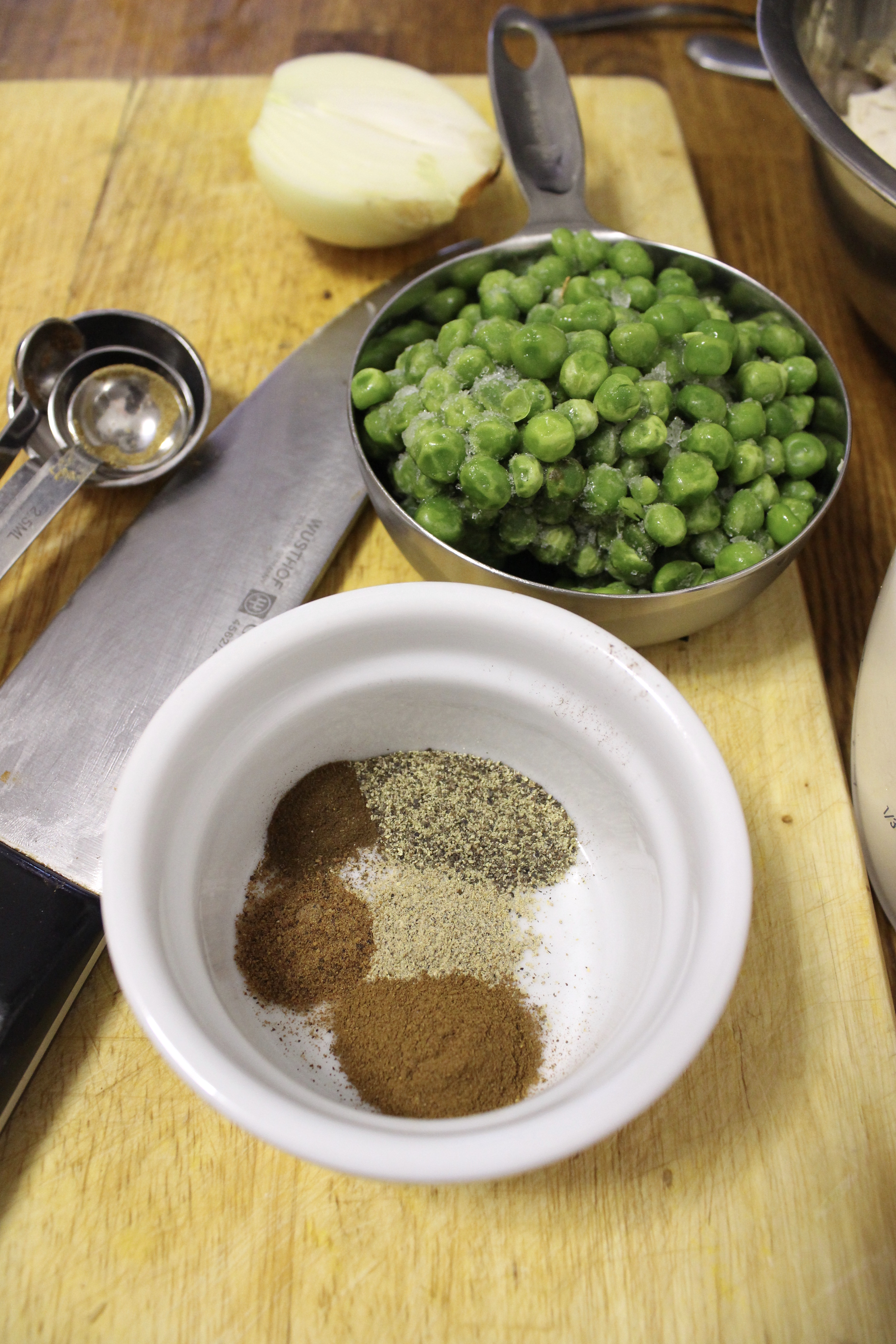
What is korma? Any meat/seafood/veggie dish cooked in a cream or yogurt or nut paste sauce. Simmered with warm spices (not the spicy spices) and slightly sweet. Chicken korma was my favorite dish growing up, but only reserved for special occasions, like Eid or birthdays.
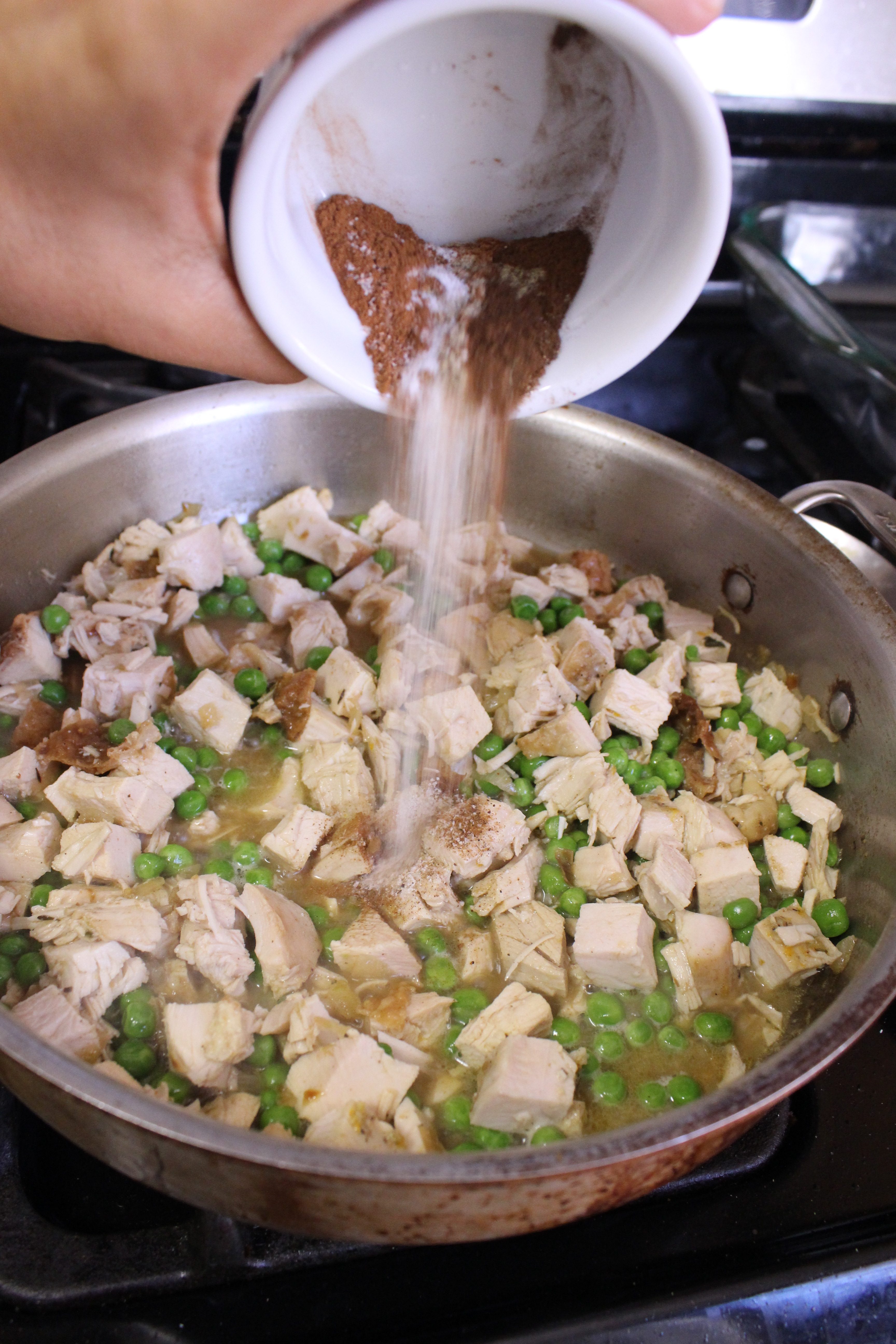
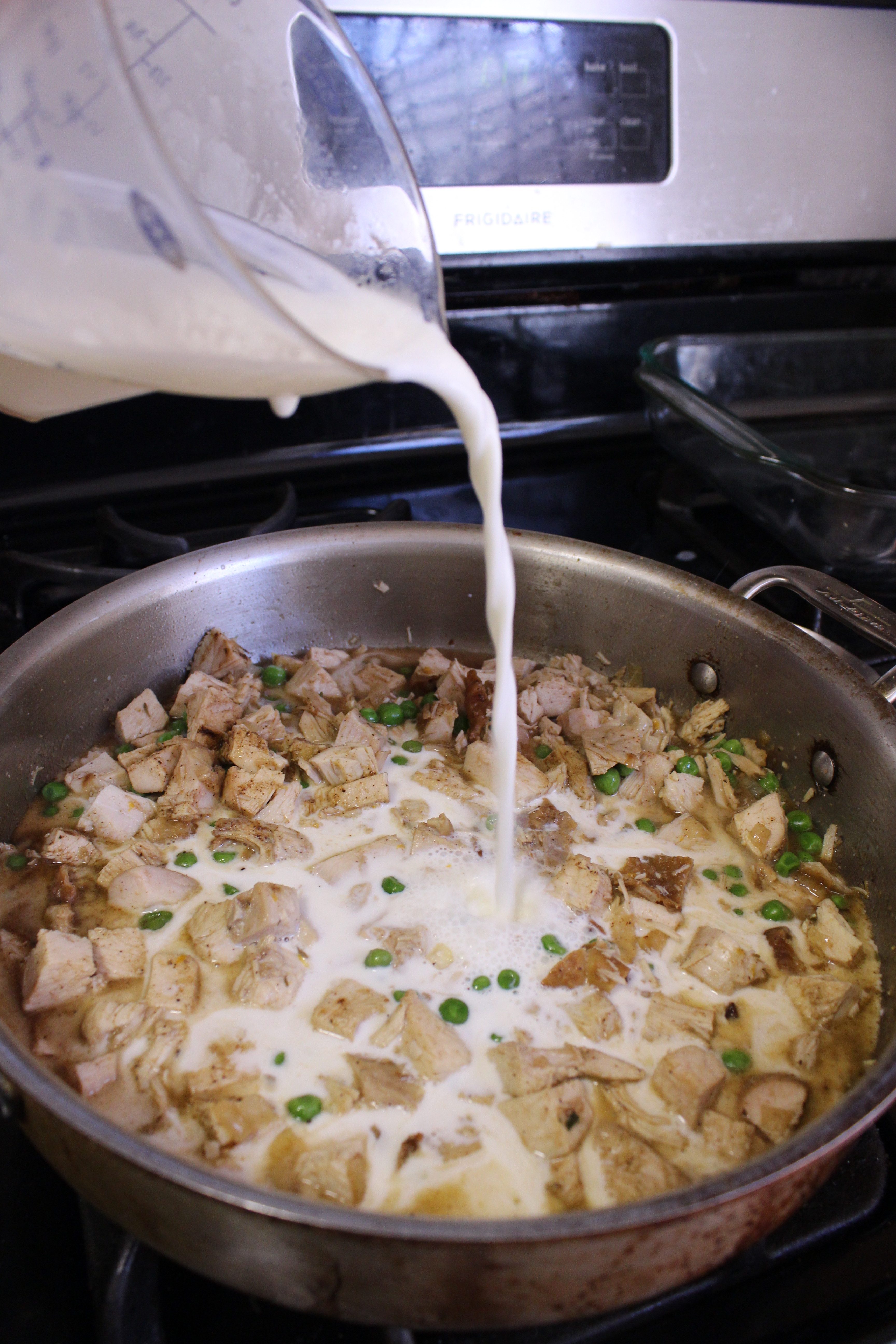
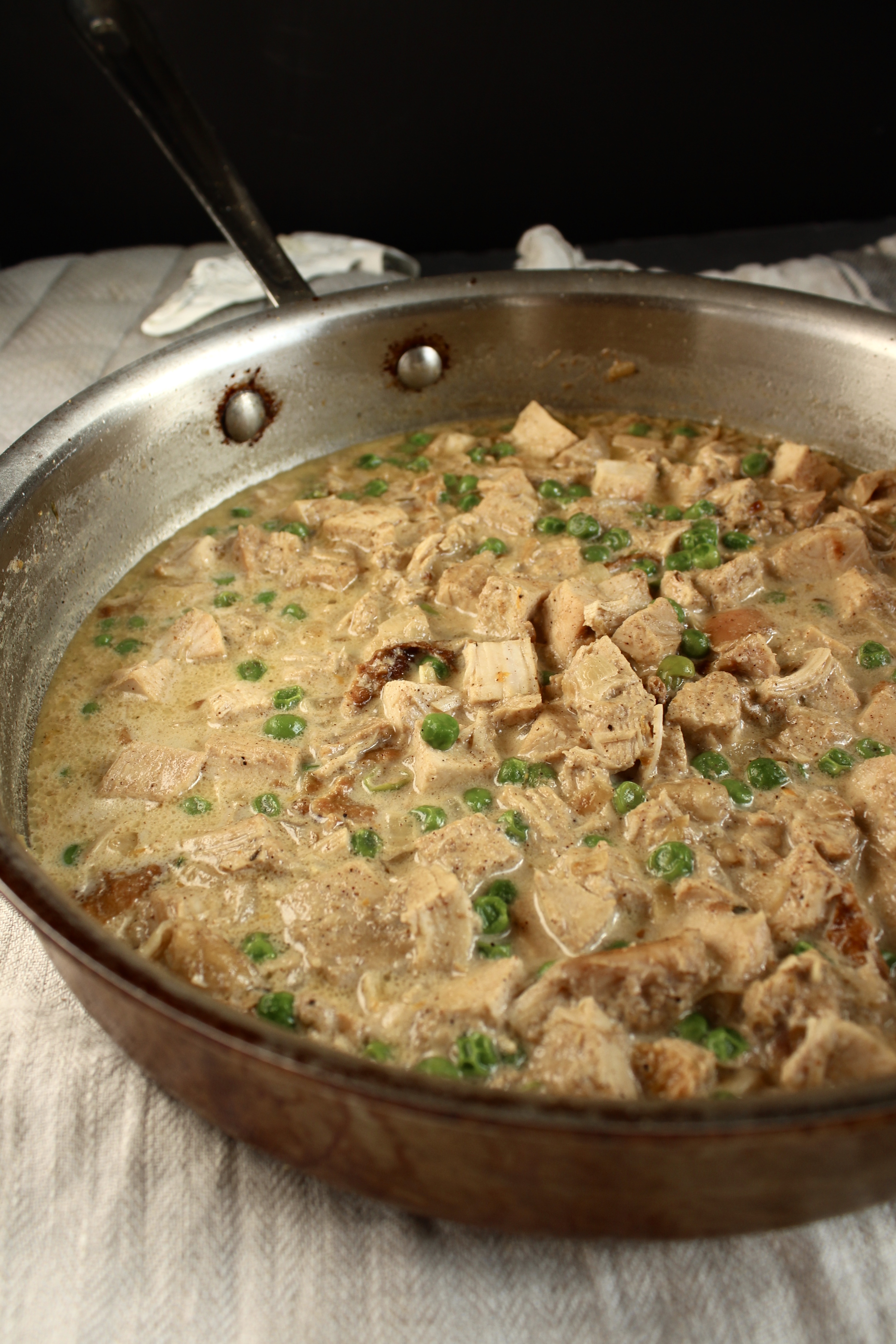
Hope you enjoy this recipe!
Ingredients
- 1/2 onion, diced
- 1 tbsp ghee or butter
- 1/2 tsp ground cumin
- 1/2 tsp ground coriander
- 1 tsp garlic/ginger paste*
- 1 cup turkey/chicken broth or water
- 2-3 cups cubed turkey breast
- 1 cup frozen peas
- 1/8 tsp nutmeg
- 1/8 tsp clove
- 1/8 tsp cardamom
- 1/4 tsp cinnamon
- 1/4 tsp black pepper
- 1/2 tsp sugar
- 1/2 tsp salt
- 3/4 cup milk
- 1/4 cup half & half
Directions
- In a large saute pan, heat ghee or butter over medium high heat and add onions. Cook until onions are translucent and lightly browned around the edges. Add the cumin, coriander and garlic/ginger paste. Stir, then slowly add the broth or water. Scrape all the browned bits from the bottom of the pan and allow mixture to simmer for 2-3 minutes.
- Add the turkey, peas and remaining spices. Stir to combine then add the milk and half and half. Let simmer for 5 minutes.
- Remove from heat and serve with rice or quinoa.
*You can sub garlic/ginger paste with 1 clove of garlic AND a small (maybe 1/2inch) piece of ginger minced or pressed through a zester.
Tandoori Chicken
 My mother, who is a great cook, simply gets green with envy at my oven utilization. She boasts to her friends how I simply toss a few ingredients together and put them all into the oven and set a timer on. No babysitting, freeing up your hands and mind to take care of the dishes, clean up a wee wee accident (what? that’s not a constant in your day to day?) or whatever else you might need to do. People in Bangladesh just don’t have ovens (or they didn’t at least when she was growing up), so the only method of food prep she’s ever known was stovetop. Luckily, I grew up in new york. I’ve used my oven to satisfy my sweet (and savory) tooth since I was a kid. So, given the craziness of everyday life here, it’s good to have a few of these marinades up your sleeves that you can prepare the morning of or night before, and toss in the oven half an hour before dinner time.
My mother, who is a great cook, simply gets green with envy at my oven utilization. She boasts to her friends how I simply toss a few ingredients together and put them all into the oven and set a timer on. No babysitting, freeing up your hands and mind to take care of the dishes, clean up a wee wee accident (what? that’s not a constant in your day to day?) or whatever else you might need to do. People in Bangladesh just don’t have ovens (or they didn’t at least when she was growing up), so the only method of food prep she’s ever known was stovetop. Luckily, I grew up in new york. I’ve used my oven to satisfy my sweet (and savory) tooth since I was a kid. So, given the craziness of everyday life here, it’s good to have a few of these marinades up your sleeves that you can prepare the morning of or night before, and toss in the oven half an hour before dinner time.  I made these homefries to go along with the chicken. The bag said they’re a good source of potassium. Yay for good carbs! Salt, pepper, paprika, garlic powder and olive oil. 425 for 25 min. Wow!
I made these homefries to go along with the chicken. The bag said they’re a good source of potassium. Yay for good carbs! Salt, pepper, paprika, garlic powder and olive oil. 425 for 25 min. Wow! The spice mix is a little tricky to put together but I highly recommend it! There is a small amount of nutmeg (compared to everything else in it) but the flavor really comes through! The flavor is more vibrant than any Shan mix you may buy (and minus the preservatives). Just spend a little bit of time one afternoon or evening to prepare the mix and you’ll have access to delicious tandoori chicken any time! I’ve actually had it sitting in my cupboard for a while (over a year) because I wasn’t crazy about the recipe that went with the mix, but I tried my hand at creating my own recipe more recently and I was blown away! I integrated a few tricks I picked up from Smitten Kitchen, namely her recipe for Buttermilk Roast Chicken. One: that 1 tbsp of salt in the marinade achieves the same effect of brining your chicken. Two: a little bit of sugar goes a long way when roasting chicken. I never was a fan of sweet/savory flavor combinations, but the amount of sugar in this recipe doesn’t make the chicken sweet, rather helps keep all the flavors balanced.
The spice mix is a little tricky to put together but I highly recommend it! There is a small amount of nutmeg (compared to everything else in it) but the flavor really comes through! The flavor is more vibrant than any Shan mix you may buy (and minus the preservatives). Just spend a little bit of time one afternoon or evening to prepare the mix and you’ll have access to delicious tandoori chicken any time! I’ve actually had it sitting in my cupboard for a while (over a year) because I wasn’t crazy about the recipe that went with the mix, but I tried my hand at creating my own recipe more recently and I was blown away! I integrated a few tricks I picked up from Smitten Kitchen, namely her recipe for Buttermilk Roast Chicken. One: that 1 tbsp of salt in the marinade achieves the same effect of brining your chicken. Two: a little bit of sugar goes a long way when roasting chicken. I never was a fan of sweet/savory flavor combinations, but the amount of sugar in this recipe doesn’t make the chicken sweet, rather helps keep all the flavors balanced.  Another thing that’s helped my cooking recently is raw ginger. I’ve always had an aversion to it. The times I would bite down on a piece while eating haleem. The sharp, unpleasant flavor it adds to drinks. So I kind of carried that into my cooking, only using small pinches of the milder version, ginger powder. But when I started using the real deal, something amazing happened: the foods I cooked reached new heights. Like, can-compete-with-my-mom heights. I used to attribute the difference in our foods to the type of salt we use (she uses table salt, I use kosher or sea salt), thinking perhaps what she uses (or the volume of it) amplifies the flavor in a way that kosher salt doesn’t. But now I really believe ginger to hold the key. It adds a depth, a warmth, that is hard to achieve with black pepper or chili powder. All in all, ginger, nutmeg, tender fall-off-the-bone meat all knocks this recipe out of the park.
Another thing that’s helped my cooking recently is raw ginger. I’ve always had an aversion to it. The times I would bite down on a piece while eating haleem. The sharp, unpleasant flavor it adds to drinks. So I kind of carried that into my cooking, only using small pinches of the milder version, ginger powder. But when I started using the real deal, something amazing happened: the foods I cooked reached new heights. Like, can-compete-with-my-mom heights. I used to attribute the difference in our foods to the type of salt we use (she uses table salt, I use kosher or sea salt), thinking perhaps what she uses (or the volume of it) amplifies the flavor in a way that kosher salt doesn’t. But now I really believe ginger to hold the key. It adds a depth, a warmth, that is hard to achieve with black pepper or chili powder. All in all, ginger, nutmeg, tender fall-off-the-bone meat all knocks this recipe out of the park.
I kept the skin on the legs, because I love a good, crispy skin. But this recipe works just as well with skinless.
Ingredients
- 6 chicken legs (thigh + drumstick)
- 1 cup of plain yogurt
- juice of a 1 lemon
- 1 tbsp salt
- 1 tbsp brown sugar
- 1 tbsp tandoori spice mix
- 2 cloves garlic, minced or made into a paste
- 1 inch piece of ginger root, minced or made into a paste
- a pinch of chili powder (optional)
- an extra drizzle of olive oil
Directions
- Make two cuts into the chicken: one at the thigh, one at the drumstick. Place in a gallon zip lock bag.
- Combine yogurt, lemon juice, salt, sugar, spice mix, garlic, and ginger in a bowl or large glass measuring cup. Pour over the chicken in the bag and zip shut. Massage the marinade into the meat. Let sit in the fridge for about 8 hours (I did mine in a hurry, about 4 hours, and although it was delicious, it makes a difference in how deeply the flavor penetrates).
- Heat oven to 425 Fahrenheit. Line a baking sheet with parchment or aluminum. Take the chicken out of the marinade, shaking off excess. Spread the chicken out (overcrowding will keep the skin from crisping) and lightly sprinkle some chili powder over the top. Drizzle with olive oil for a nice tan, and bake for 30-35 minutes, depending on the size of the individual legs. The meat should be cooked through, but if your meat isn’t nicely browned, turn the heat up to 450 and bake for an additional 5 minutes. I had some leftover (halal beef) bacon grease from the morning, so I used that instead =)
- Serve with naan, home fries, or just a nice salad. Extra points for homemade cilantro yogurt dipping sauce (recipe to come!).
Pastitsio
 I’ve already written about Pastitsio. But since it didn’t exactly get its close up last time, I figured it was time for a redo. Pastitsio, btw, is a baked pasta dish, layered with meat sauce, bechamel and parmesan (or kasseri). Even though there are a few steps (and several pots and pans) required to make this dish, the flavor is out of this world. It all started when I bought some ground lamb on impulse. Tired of chicken or beef or beef or chicken, I reached for the lamb. Then days passed as I’d open the freezer door, stare at it to figure out what I could do with it (meatballs, kebabs), then close the door again. Then I decided, it was time to remake this lovely casserole. I had to buy some ground beef anyway, as the combination of the two types of meat helps mellow the strong flavor of the lamb. The cinnamon and lamb is such an unlikely combination, but it just works. Along with the thyme, garlic and oregano, the aromatics perfume the whole house. This time though
I’ve already written about Pastitsio. But since it didn’t exactly get its close up last time, I figured it was time for a redo. Pastitsio, btw, is a baked pasta dish, layered with meat sauce, bechamel and parmesan (or kasseri). Even though there are a few steps (and several pots and pans) required to make this dish, the flavor is out of this world. It all started when I bought some ground lamb on impulse. Tired of chicken or beef or beef or chicken, I reached for the lamb. Then days passed as I’d open the freezer door, stare at it to figure out what I could do with it (meatballs, kebabs), then close the door again. Then I decided, it was time to remake this lovely casserole. I had to buy some ground beef anyway, as the combination of the two types of meat helps mellow the strong flavor of the lamb. The cinnamon and lamb is such an unlikely combination, but it just works. Along with the thyme, garlic and oregano, the aromatics perfume the whole house. This time though
- I substituted portobello mushrooms in lieu of some of the meat,
- Decreased the amount of cinnamon from 1 tablespoon to 1 teaspoon and really preferred it that way,
- Used large eggs instead of extra large (sorry Ina, that’s just what I have on hand),
- Used regular whole milk yogurt that I strained in a paper towel in bowl to get rid of the excess moisture,
- And didn’t have fresh thyme so dried it is!
This is the recipe according to the way I made it this time. Enjoy!
Ingredients:
- 1 large Spanish onion, minced
- 3 tbsp olive oil olive oil
- 3/4 lb ground beef
- 3/4 lb ground lamb
- 1 tbsp (or 3 large cloves) garlic
- 2 portobello mushroom caps, cut into about 1/4 inch cubes
- 1 tsp ground cinnamon
- 1 tsp dried oregano
- 1 tsp dried thyme
- 1/4 tsp chili powder
- 2 tsp salt
- 1 tsp ground black pepper
- 4 tbsp butter
- 1/4 cup flour
- 1.5 cups whole milk
- 1 cup heavy cream (that’s right, butter, cream, beef and lamb. in one dish.)
- 1/4 tsp nutmeg
- 1 tsp salt
- 1 tsp pepper
- 3/4 cup parmesan
- 3/4 lb small or medium shell pasta
- 3/4 cup parmesan
Directions
- Preheat oven to 350 degrees F.
- Heat oil over medium high heat in a large pot. Add onions and cook for about 5 minutes. Add the meat and lamb, breaking up the chunks with a wooden spoon. Cook until no longer pink, about 8 minutes. Add mushrooms, garlic, cinnamon, oregano, thyme, chili powder, salt and pepper. Stir to combine. Cover and lower the heat to a simmer. Let cook for about 45 minutes, stirring occasionally.
- While that’s going, bring a pot of water to boil for pasta. In a large saucepan, melt the butter over low heat. Add the flour. Whisk together and cook the flour for about 2 minutes. Slowly add the milk and cream, whisking constantly to ensure there are no clumps. Keep whisking until the mixture thickens (about 4 minutes). It should be thick enough so when you pull a wooden spoon out of it, you can run your finger down the sauce on the back of the spoon and it stays separate. Off the heat, add the nutmeg, salt, pepper and parmesan.
- Cook the shells according to the directions on the box, taking care not to over cook it (as it continues to cook in the oven). Once it’s done, add it to the meat sauce and stir to combine.
- To assemble: lightly grease a casserole dish. Add pasta with the meat sauce. Add the bechamel sauce over. Then sprinkle the rest of the parmesan (I accidentally added the pasta to the bechamel sauce first, so everything kind of got combined beforehand…no complaints here!).
- Baked in the preheated oven for 60 minutes or until golden on top and bubbling.
Haleem
 Warning: this post isn’t about finding the mother of all haleem recipes. I’m not even gonna say it will give your grandma’s a run for her money (though it’s darn good). No, this post is about accessibility. Haleem is not an enigma. Sure, there’s barley, wheat, lentils, even dried papaya. But you don’t have to go out of your way looking for ingredients you don’t usually stock your pantry with. Nor do you have to run to Jamaica or Jackson Heights, or wherever you go for your fix. Instead, you pick up a box of Shan’s Easy Cook Haleem mix and get ready to wow the salwars off your friends and family.
Warning: this post isn’t about finding the mother of all haleem recipes. I’m not even gonna say it will give your grandma’s a run for her money (though it’s darn good). No, this post is about accessibility. Haleem is not an enigma. Sure, there’s barley, wheat, lentils, even dried papaya. But you don’t have to go out of your way looking for ingredients you don’t usually stock your pantry with. Nor do you have to run to Jamaica or Jackson Heights, or wherever you go for your fix. Instead, you pick up a box of Shan’s Easy Cook Haleem mix and get ready to wow the salwars off your friends and family.
 Let me first back up a bit for those of you who aren’t familiar. Haleem is a thick, spicy stew made by creating a flavorful broth of spices and meat (usually goat meat or chicken), then thickening with lentils, barley and wheat. It is traditionally eaten during Ramadan, at iftar (or evening breakfast). But it’s so warm, spicy and hearty – it’s really ideal for the dead of winter!
Let me first back up a bit for those of you who aren’t familiar. Haleem is a thick, spicy stew made by creating a flavorful broth of spices and meat (usually goat meat or chicken), then thickening with lentils, barley and wheat. It is traditionally eaten during Ramadan, at iftar (or evening breakfast). But it’s so warm, spicy and hearty – it’s really ideal for the dead of winter!
The box includes a spice mix (which you totally don’t need all of). It is really, really spicy and salty, so I only use like 2/3 of the packet. Use 1/2 if you’re a spice eating lightweight. It also includes the lentils and grains, pulverized, so you wouldn’t need to soak them overnight like in a traditional haleem. Again – accessibility! The instructions neglect one very important ingredient: garlic/ginger paste (or finely minced garlic and ginger). Make sure to add a good heaping tablespoon to the meat as it cooks. And finally, contrary to what it says on the box, it is not ready in 30 minutes, even if you have a pressure cooker! For me, goat meat (or mutton) takes a good hour and half over a low flame, with the lid on, to get fully tender. I also get the onions going very early on, because I like to caramelize my onions low and slow. Once you do add the grains, they tend to clump up. So add them slowly, and stir continually, to breakdown any clumps.

 Traditionally, you serve it with chopped cilantro, grated ginger, crispy onions, a slice of lemon/lime, and perhaps some green chilis. Not here. I loathe fresh ginger and raw chilis. I just like to add the cilantro and citrus to brighten up an otherwise long-going stew (cook time was 2 hrs!). This serves about 8-10 people. And even though Ramadan is coming to an end, it’s a great dish for your Eid spread!
Traditionally, you serve it with chopped cilantro, grated ginger, crispy onions, a slice of lemon/lime, and perhaps some green chilis. Not here. I loathe fresh ginger and raw chilis. I just like to add the cilantro and citrus to brighten up an otherwise long-going stew (cook time was 2 hrs!). This serves about 8-10 people. And even though Ramadan is coming to an end, it’s a great dish for your Eid spread!
Ingredients
- 1 box Shan Haleem mix (including spice mix and grains)
- 1/2 cup oil
- 1 heaping tbsp garlic/ginger paste
- 1.5 lbs mutton or chicken (don’t cop out and make the chicken one!), cut into pieces
- 15 cups water
- 1 large onion, or 2 medium
- cilantro, fried onion, ginger, green chilis and/or lemon wedge for garnish
Directions
- In a large pot, heat up half a cup of vegetable oil or ghee over medium high heat. Add 1/2 to 2/3 of the spice packet. Add the meat and garlic/ginger paste and stir to combine.
- Add water, bring to a boil over high heat. Then lower the heat, put the lid back on and simmer for an hour, hour and a half. Stir occasionally to make sure no funky stuff is going on. Meat should be tender and falling off the bones when done. Taste for seasoning.
- While the meat is going, thinly slice the onion and add to a separate fry pan over low heat, to two tablespoons oil. Stir occasionally, increasing frequency towards the end. It take a bit of babysitting (after about 20 minutes) to make sure the edges don’t burn. Once they’re browned, turn off the heat.
- Meanwhile, from the haleem pot: take the meat out, and shred it using your hands or two forks. Then add the meat back into the broth along with the contents of the grains packet. Stir continuously to make sure there are no clumps. After 20-30 minutes, add caramelized onions and remove from heat. Add a cup of water if it looks too thick.
- Serve with cilantro, fried onion, slices of ginger, green chilis and/or lemon/lime.
Mashed Eggplant (Begun Bhorta)
I feel like most people, when asked what their favorite vegetable is, would say corn or butternut squash or potatoes (though I bet they actually like the salt and fat that comes with the potatoes). Or perhaps mushrooms. But not me. I. Love. Eggplant. Stewed with tomatoes (imam biyaldi). Simply fried with salt and turmeric (chaak bhaji). In a curry with the insanely boney hilsa fish. In the Sicilian sweet/savory relish known as caponata. In every way except babaghanoush (sorry, haters gon hate). Or this way: charred over an open flame, peeled then mashed with simmering onions, tomatoes, garlic and spices.
 Now, I know traditionally a bhorta consists of some boiled or steamed vegetable (or dried fish) mashed or really well mixed with raw onion, Thai chilli, mustard oil, salt and cilantro. But one fine day my mom made this and said hey, this is begun bhorta. And even though the cooking process more closely resembles a mishti kumro ghonto (think: spiced, simmered pumpkin mush), it stuck.
Now, I know traditionally a bhorta consists of some boiled or steamed vegetable (or dried fish) mashed or really well mixed with raw onion, Thai chilli, mustard oil, salt and cilantro. But one fine day my mom made this and said hey, this is begun bhorta. And even though the cooking process more closely resembles a mishti kumro ghonto (think: spiced, simmered pumpkin mush), it stuck.
 Charring it is a bit of a pain. The juices get all over the burner. Peeling the charred pieces of skin is a pain. But the payoff is well worth it. You could perhaps do it under the broiler. I haven’t given it a go. Right now I am sticking to tried and true methods of prep. So, here it is:
Charring it is a bit of a pain. The juices get all over the burner. Peeling the charred pieces of skin is a pain. But the payoff is well worth it. You could perhaps do it under the broiler. I haven’t given it a go. Right now I am sticking to tried and true methods of prep. So, here it is:
Ingredients:
1 medium eggplant, poked all around with a knife or fork
1 tbsp olive oil
1 small onion, diced (yellow or red)
2 cloves garlic, minced (or 1tsp garlic paste)
1 tomato, diced
1/4 tsp cumin
1/4 tsp turmeric
1/4 tsp coriander
A pinch of chilli powder
1/2 tsp salt, plus more to taste
A handful of fresh cilantro
Directions:
Over a medium flame, start charring the eggplant by placing directly onto heat and rotating using a pair of tongs every two minutes or so (or with your fingers if you’re hardcore like my mom). It should be cooked all the way through in about 10 to 12 minutes. Prep the rest of the ingredients in the meantime.
When the eggplant is done, remove from heat and allow to cool. Then peel off the skin using your fingers or tongs, doing the best you can to get as much of it off as you can. Cut off the top and set aside.
Heat oil over medium high heat in a wok or fry pan. Add onions and tomatoes. Allow to soften a few minutes, then add garlic and the rest of the spices/seasonings (if you only have garlic/ginger paste on hand, use that). Add the eggplant and break up any chunks using a wooden spoon. Lower the heat to medium/medium low. Mix it all together and let the flavors combine while prepping the cilantro.
Off the heat, add the cilantro and check for seasoning. Serve with basmati rice or roti.
Note: as with most bengali cooking, you do not need to follow a recipe to a T to get fantastic results. Feel free to use chopped Thai chili in lieu of the chili powder. Or a dash of mustard oil for more of a kick. For example, I had some extra red pepper on hand so I added it. Made it look a ton prettier. Just don’t skimp on the charring because it really makes this dish.
Bengali Chicken Curry
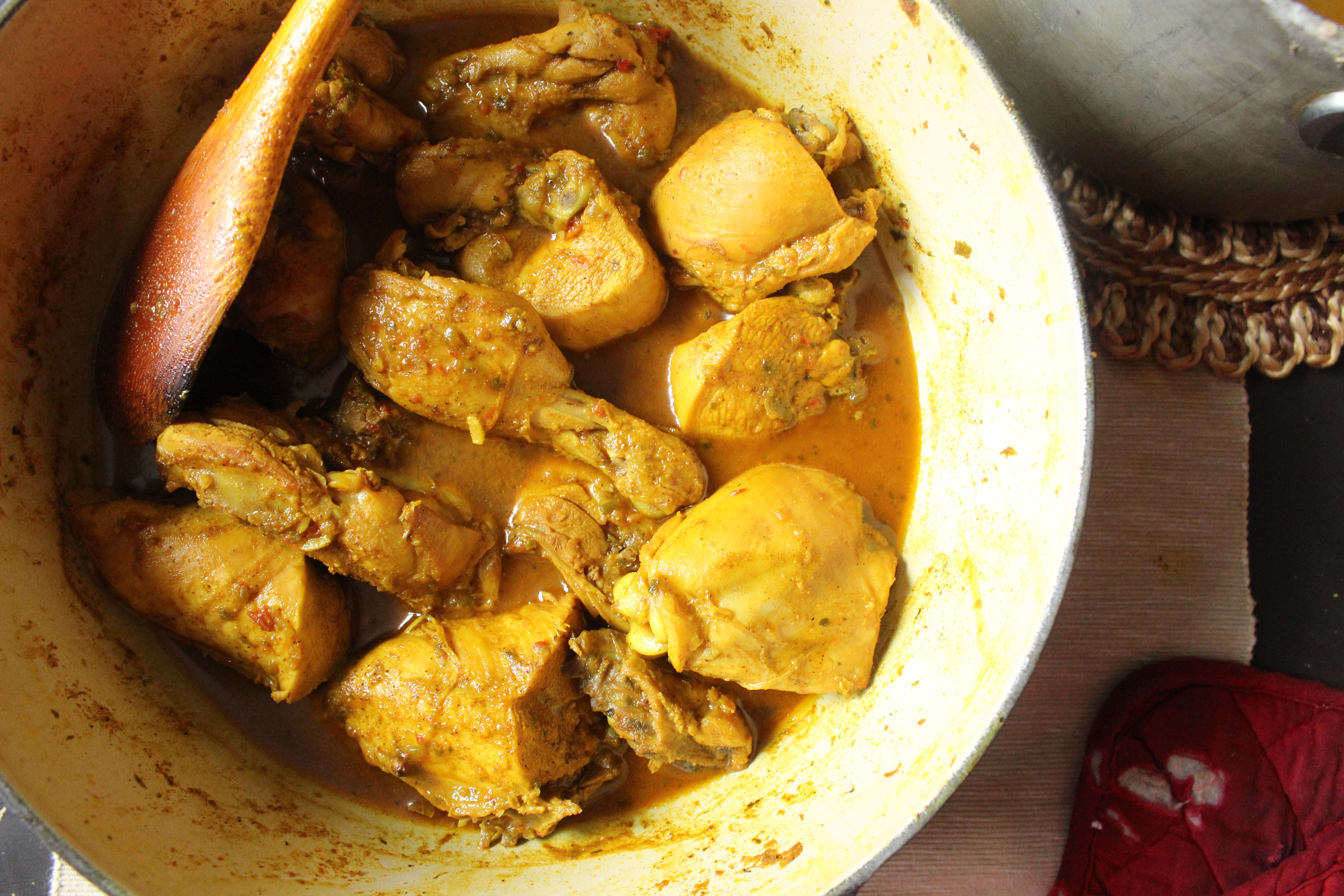 There is no coconut milk in your chicken curry if you are Bengali. There is no curry paste or any other amalgamation of ingredients someone else deems necessary for your comfort-in-a-bowl chicken curry. There is only your mother, your childhood, the pieces of white meat that no one ever wanted, the potatoes that you cared for only on some days, the jhol (broth) that was literally chicken soup for your soul (but only the first day, after that it just got too cardamom-y), and the leftover bones that you LOVED to chew on as you churned out every last drop of flavor but NEVER admitted to doing outside of bengali circles.
There is no coconut milk in your chicken curry if you are Bengali. There is no curry paste or any other amalgamation of ingredients someone else deems necessary for your comfort-in-a-bowl chicken curry. There is only your mother, your childhood, the pieces of white meat that no one ever wanted, the potatoes that you cared for only on some days, the jhol (broth) that was literally chicken soup for your soul (but only the first day, after that it just got too cardamom-y), and the leftover bones that you LOVED to chew on as you churned out every last drop of flavor but NEVER admitted to doing outside of bengali circles.
Of course this is my childhood we are recollecting and thus my mother’s recipe. There is very little room for improvement…though one could probably use chicken stock (even better, homemade chicken stock) in lieu of the water. Let’s leave that for another day, another post. For now, amidst the pristine image laid out for you of a little girl enjoying every minute of being elbow deep in her favorite food, there are some hidden perils that threaten. Hear me out: have you ever, during the course of your meal ever landed on a “flavor bomb” ? One of those whole peppercorns, cloves or worse, entire cardamom pod?? It’s disgusting! It’s painful! It’s downright heinous. Takes half the joy out of the meal. I just thought of taking the extra step of pouring the jhol through a sieve and voila! Flavor. Bomb. Out.
I hope this recipe takes you back to your childhood!
Ingredients
- 1/4 cup vegetable oil
- 1 medium yellow onion, sliced
- 1 heaping tsp cumin power
- 1 heaping tsp coriander
- 1 tsp turmeric
- 1/2 tsp chili powder (use more or less depending on the potency of your chili powder and how spicy you like it)
- 1 3 lb chicken cut into curry pieces (either 10 or 12 pieces in total)
- 1 tsp garlic paste (or minced garlic)
- 1 tsp ginger paste (or minced ginger)
- 1 – 1.5 cups of water (water should come about 2/3 of the way up the sides, not covering the meat)
- 1.5 tsp kosher salt, plus more to taste
- 1 bay leaf
- 1 cinnamon stick or 1 tsp ground cinnamon
- 4 whole cloves
- 4 whole cardamom pods or 1/4 tsp cardamom
- 5-6 whole peppercorns
Directions
- Heat the oil over medium high heat in a saucepan or any medium sized pot (about 4 qts) with high sides. Add the onion and let soften for 4-5 min. While onion cooks, prep your garlic and ginger, if necessary, and combine the ground spices in a bowl.
- Add spices to the onions, mixing well. Add the chicken pieces, turning to coat with as much of the masala mixture as possible. Let the chicken and spices cook for 4-5 minutes, taking care not to burn the spices (reduce the heat if necessary). Add garlic, ginger, water, salt, bay leaf, cinnamon, cloves, cardamom and peppercorns. Stir, then increase the heat to bring to a boil.
- Reduce to a simmer and cover. Let simmer for 20-25 minutes, removing the lid during the last 10 minutes if there is too much liquid.
- Check for seasoning. Add more salt or spice as needed.
- Optional: Transfer chicken pieces to a serving bowl. Pour the broth through a sieve to catch all the whole spices and push through all the last bits of curry through the sieve using a spoon.
Variations
For a bigger (4 to 5 lb chicken)
- 1/3 cup vegetable oil
- 1.5 to 2 small yellow onions, sliced
- 1.5 heaping tsp cumin power
- 1.5 heaping tsp coriander
- 1.5 tsp turmeric
- 3/4 tsp chili powder (use more of less depending on the potency of your chili powder and how spicy you like it)
- 1 4 to 5 lb chicken cut into curry pieces (about 12 in total)
- 1.5 tsp garlic paste (or minced garlic)
- 1.5 tsp ginger paste (or minced ginger)
- about 2 cups of water
- 2 tsp kosher salt, plus more to taste
- 1 bay leaf
- 1 cinnamon stick
- 5-6 whole cloves
- 5-6 whole cardamom pods
- 7-8 whole peppercorns
Increase cooking time by 2-3 minutes, testing the thickest part of the thigh to check for doneness.
To give it a refresh
Try sautéing some tomatoes into a large fry pan or wok and add the leftover chicken curry. When thoroughly heated through, remove from heat and add some chopped fresh cilantro.
Your Mama’s Goat Curry (almost)
 I wanted this blog to be part-South Asian cooking primer, part musings on Mediterranean/American/Italian cuisine and part dessert food-porn. I haven’t had much opportunity to cook South Asian food post baby no.2, mainly because I’ve been blessed with my mom’s good old home cooking most of the time.
I wanted this blog to be part-South Asian cooking primer, part musings on Mediterranean/American/Italian cuisine and part dessert food-porn. I haven’t had much opportunity to cook South Asian food post baby no.2, mainly because I’ve been blessed with my mom’s good old home cooking most of the time.
But since it was Eid ul Fitr and my mom ran off to the homeland for a month, I got a chance to whip up some of the good stuff. The stuff that when I asked my husband to give a taste, rolled his eyes back and said “THIS is what makes the world go round”. Now, I won’t take all the credit. It’s a pretty standard curry recipe: onions, garlic, spices – with the exception of tomato paste. That’s a nifty little trick I learned from my mother in law. Intense tomato flavor and meat tenderizer in one. But it’s the meat that makes all the difference. Goat meat, very popular in the subcontinent, not so much in the states – is so flavorful, so tender. Though not as overpowering as lamb can be. I usually get ~3lbs from the shoulder/ribs/foreshank area.
I know it looks like a lot of ingredients, but they are seriously things to invest in if you enjoy south asian cooking.
Ingredients:
- 1/4 cup vegetable oil
- 1 large yellow onion or 2 small
- 2 tbsps garlic/ginger paste (or 5 garlic cloves and 1.5 in ginger root, minced)
- 1 tbsp tomato paste
- 2 tsps cumin powder
- 2 tsps coriander powder
- 1/4 tsp cayenne powder
- 2 tsps turmeric
- 4-5 lbs goat meat (cut into small pieces)
- 2 tsp salt, plus more to taste
- 6 cardamom pods
- 6 cloves
- 2 cinnamon sticks
- 4-5 peppercorns
- 2 bay leaves
- 2.5 cups water
Directions
Heat oil over medium high heat in a nice, big pot. Slice onion and add to hot oil. Let it soften (for 5 to 8 minutes) and add the garlic/ginger paste, tomato paste, cumin, coriander, chilli and turmeric and mix well. Let the spices cook for 2-3 minutes, adding water as necessary to keep he spices from sticking to the bottom. Add the goat meat pieces and stir to coat every piece with the flavor base. Let cook for 10 minutes (similar to the searing stage of a meat braise). Add salt, then the garam masala (cardamom, cloves, cinnamon and peppercorns). Add water and bring to a boil. Then cover and reduce the heat to medium-low. Let simmer for 45-90 minutes, depending on the age of the goat. Young goat cooks in as little as 45 min.
Taste for doneness (meat should be tender) and seasoning.

